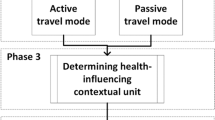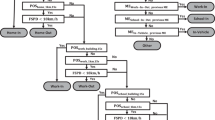Abstract
Global positioning system (GPS) data recorders were worn by subjects in the Oklahoma Urban Air Toxics Study (OUATS) for automatic logging of their location as they went about their normal daily activities. The location information obtained by the GPS units had an uncertainty of about 10–20 m, which was sufficiently precise to track subjects' movements on trips outside the immediate vicinity of their homes. Due to instrument problems, primarily related to reduced battery life, the units operated for only about 30% of the total monitoring time attempted in 25 trials. The GPS data were compared to time–activity diaries kept by the subjects. In almost all cases, the GPS data confirmed all travel events reported in the subjects' diaries. Additionally, in five out of five trials in which the logging period covered most or all of the subjects' daytime activities, at least one travel event that was not recorded in the diary was detected by GPS. Notwithstanding the limitations of present technology, GPS was found to be a promising means for tracking of research subjects in community-based exposure assessment studies.
This is a preview of subscription content, access via your institution
Access options
Subscribe to this journal
Receive 6 print issues and online access
$259.00 per year
only $43.17 per issue
Buy this article
- Purchase on Springer Link
- Instant access to full article PDF
Prices may be subject to local taxes which are calculated during checkout



Similar content being viewed by others
References
Freeman NCG Lioy PJ Pellizzari E Zelon H Thomas K Clayton A and Quackenboss J, Responses to the Region 5 NHEXAS time/activity diary. J Exposure Anal Environ Epidemiol (1999) 9: 414–426
Harvey AS Szalai A Elliott DH Stone PJ and Clark SM, Time Budget Research: An ISSC Workbook in Comparative Analysis Campus Verlag, Frankfurt, Germany, 1984
Lyon LJ and Burcham MG, Tracking Elk Hunters with the Global Positioning System U.S. Departmental of Agriculture, Forest Service, RMRS-RP-3, Ogden, UT, 1998
Ott WR, Total human exposure. Environ Sci Technol (1985) 19: 880–886
Robinson JP and Godbey G, Time for Life Penn State Press, State College, PA, 1997, pp. 57–67
Robinson JP and Silvers A, Measuring potential exposure to environmental pollutants: time spent with soil and time spent indoors. J Exposure Anal Environ Epidemiol (2000) 10: 341–354
Schutz Y, and Chambaz A, Could a satellite-based navigation system (GPS) be used to assess the physical activity of individuals on earth?. Eur J Clin Nutr (1997) 51(5): 338–339
U.S. EPA, GIS Technical Memorandum 3: Global positioning systems technology and its application in environmental programs U.S. EPA/600/R-92/036, Washington, DC, 1992
Wallace LA Pellizzari ED Hartwell TD Sparacino C Whitmore R Sheldon L Zelon H and Perritt R, The TEAM Study: personal exposures to toxic substances in air, drinking water, and breath of 400 residents of New Jersey, North Carolina, and North Dakota. Environ Res (1987) 43: 290–307
Wallace L, Nelson W, Ziegenfus R, Pellizzari E, Michael L, Whitmore R, Zelon H, Hartwell T, Perritt R, and Westerdahl D, The Los Angeles TEAM Study: personal exposures, indoor–outdoor air concentrations, and breath concentrations of 25 volatile organic compounds. J Exposure Anal Environ Epidemiol (1991) 1: 157–192
Acknowledgements
This research was funded by the U.S. Environmental Protection Agency National Center for Environmental Research and Quality Assurance under Agreement No. R82-6786-010. Rod Clinkenbeard, Aaron Gibson, and David Altom assisted with data collection and software manipulation. The authors thank the study participants for their cooperation. This work was the subject of a platform presentation at the American Industrial Hygiene Conference and Exposition in Orlando, Florida on May 24, 2000.
Author information
Authors and Affiliations
Corresponding author
Rights and permissions
About this article
Cite this article
PHILLIPS, M., HALL, T., ESMEN, N. et al. Use of global positioning system technology to track subject's location during environmental exposure sampling. J Expo Sci Environ Epidemiol 11, 207–215 (2001). https://doi.org/10.1038/sj.jea.7500161
Received:
Accepted:
Published:
Issue Date:
DOI: https://doi.org/10.1038/sj.jea.7500161
Keywords
This article is cited by
-
The development and validation of a prototype mobility tracker for assessing the life space mobility and activity participation of older adults
BMC Geriatrics (2020)
-
CareConekta: study protocol for a randomized controlled trial of a mobile health intervention to improve engagement in postpartum HIV care in South Africa
Trials (2020)
-
Improving detection of tuberculosis among household contacts of index tuberculosis patients by an integrated approach in Myanmar: a cross-sectional study
BMC Infectious Diseases (2018)
-
Assessing and enhancing the utility of low-cost activity and location sensors for exposure studies
Environmental Monitoring and Assessment (2018)
-
Classification of indoor-outdoor location using combined global positioning system (GPS) and temperature data for personal exposure assessment
Environmental Health and Preventive Medicine (2017)



